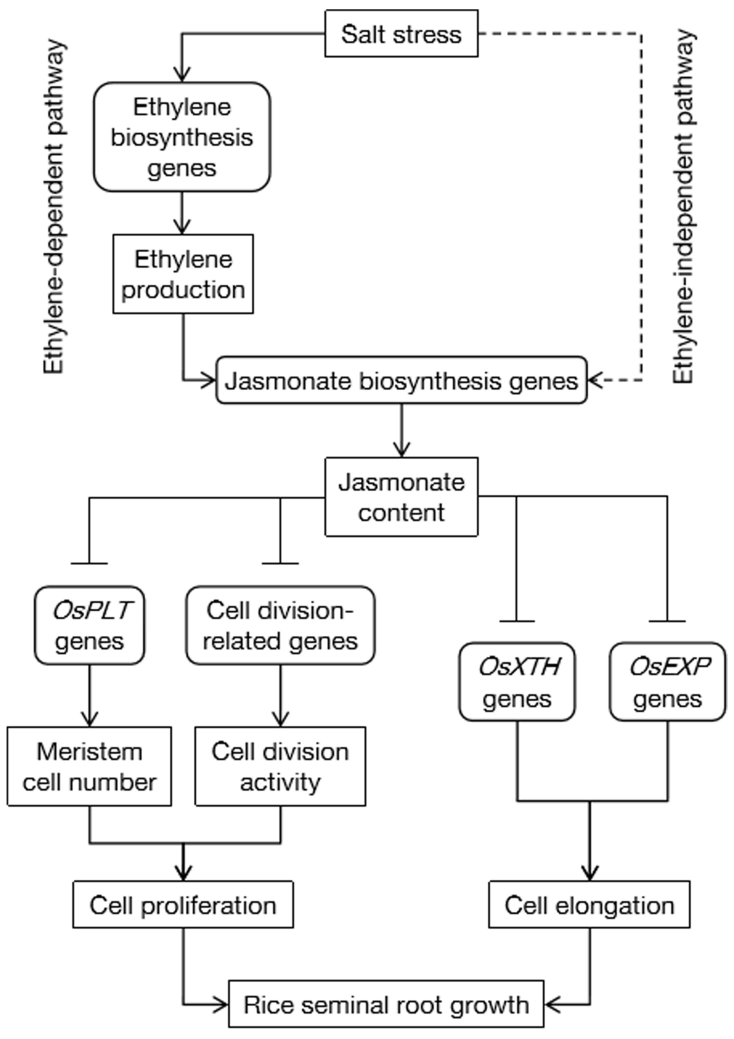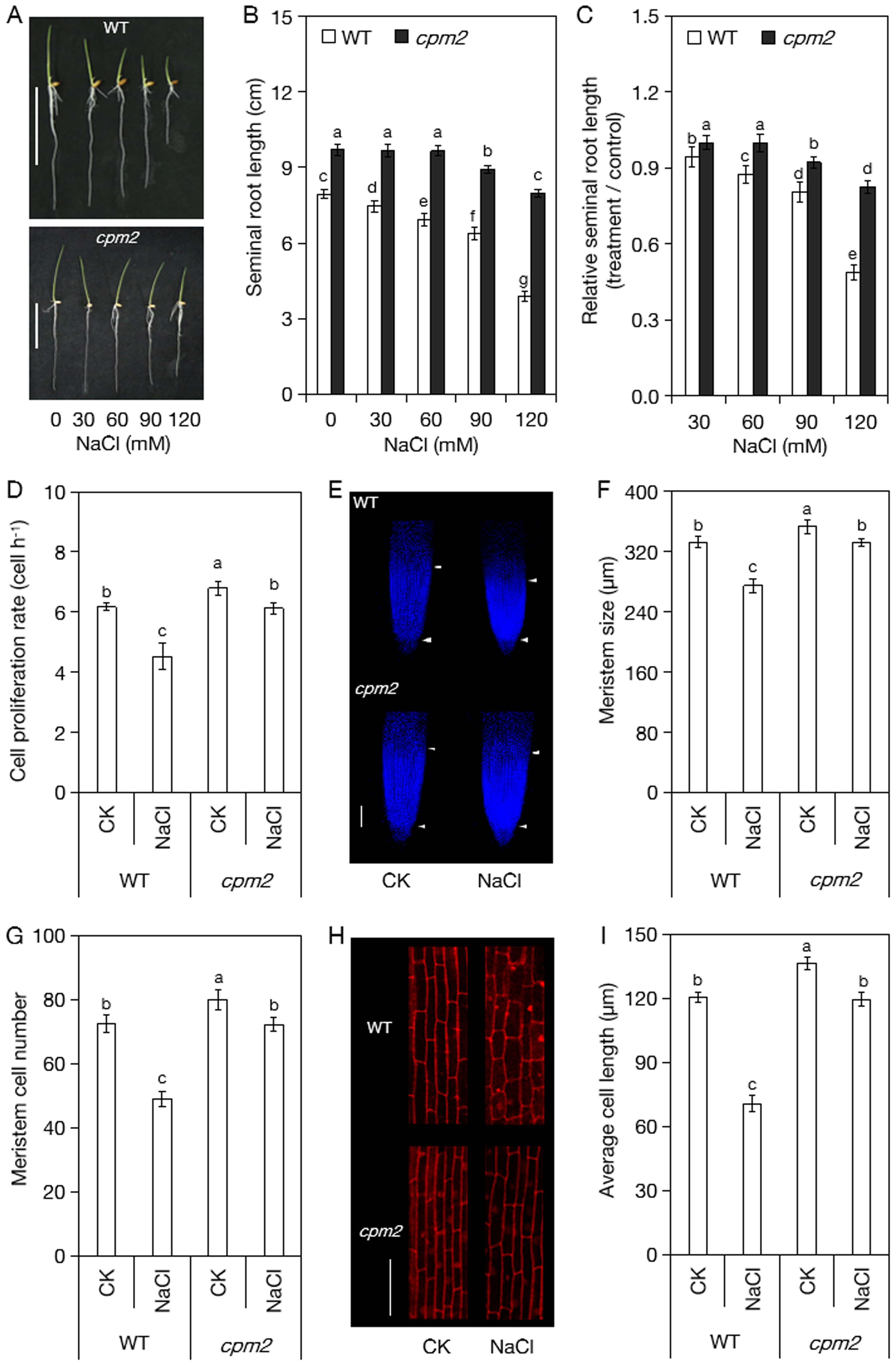南湖新闻网讯(通讯员 邹潇)近日,我校植物科学技术学院尹昌喜课题组揭示了乙烯-茉莉酸互作介导水稻根系响应盐胁迫的调控机制。
盐胁迫是限制全球粮食作物生产的主要非生物胁迫之一。据统计,全世界约有9.3亿hm2的土地遭受盐渍化,约20%的灌溉土地受到盐渍化影响,其中我国的土壤盐渍化面积大约有3600万hm2,严重限制着我国粮食生产。水稻(Oryza sativa L.)是世界上最重要的粮食作物之一,全球约有一半人口以稻米作为主粮。然而,盐胁迫会造成水稻生长发育受阻,最终导致水稻减产。因此,探究水稻耐盐机制,有望为培育耐盐水稻品种、提高盐渍化土地的水稻产量提供理论依据和实践指导,进而保障我国乃至全球的粮食安全。植物激素乙烯(ETH)和茉莉酸(JA)被称为逆境激素,它们参与调控植物响应多种逆境。然而,ETH与JA互作调控水稻种子根响应盐胁迫的分子机制尚不清楚。

图1. 水稻种子根响应盐胁迫的调控机制模式图
该研究发现,盐胁迫通过上调ETH生物合成基因OsSAMS、OsACS和OsACO的转录来促进ETH生物合成;然而,盐胁迫诱导的乙烯不能直接抑制水稻种子根生长,而是通过促进JA的生物合成间接地抑制水稻种子根的生长。此外,盐胁迫还可以通过ETH非依赖途径促进JA的生物合成,进而抑制水稻种子根的生长(图1)。进一步研究发现,盐胁迫诱导的JA通过下调OsPLT和细胞分裂相关基因的转录来抑制根分生组织细胞的增殖,盐胁迫诱导的JA还能通过下调OsXTH和OsEXP的转录来抑制根细胞的伸长,从而抑制水稻种子根的生长(图1)。

图2. JA通过介导根细胞增殖和细胞伸长调控水稻种子根生长
此外,通过比较JA缺失突变体cpm2与其相应野生型水稻的种子根在响应盐胁迫方面的差异,证实了JA能够调控水稻耐盐性(图2)。这意味着通过分子标记辅助选择技术、转基因与基因编辑等技术调控JA代谢或信号有望增强水稻耐盐性。该研究成果为培育耐盐水稻品种、提高盐渍化土地的水稻产量提供了理论依据。可见,该研究成果具有广阔的应用前景。
审核人:尹昌喜
【英文摘要】
The phytohormones ethylene and jasmonate play important roles in the adaption of rice plants to salt stress. However, the molecular interactions between ethylene and jasmonate on rice seminal root growth under salt stress is unknown. In this study, effects of NaCl on the homeostasis of ethylene and jasmonate and on the rice seminal root growth were investigated. Our results indicate that NaCl treatment promotes ethylene biosynthesis by up-regulating transcription of ethylene biosynthesis genes, whereas NaCl-induced ethylene cannot inhibit rice seminal root growth directly, but rather inhibits growth indirectly by promoting jasmonate biosynthesis. NaCl treatment also promotes jasmonate biosynthesis through an ethylene-independent pathway. Moreover, the analysis results of quantitative real-time PCR and confocal microscopy demonstrate that NaCl-induced jasmonate restricts root meristem cell proliferation by reducing meristem cell number and cell division activity via down-regulated transcription of OsPLT and cell division-related genes, respectively. Additionally, NaCl-induced jasmonate inhibits root cell elongation by down-regulating transcription of cell elongation-related genes, which in turn inhibits seminal root growth. Overall, salt stress promotes jasmonate biosynthesis through ethylene-dependent and -independent pathways in the rice seminal root, and salt-induced jasmonate inhibits the rice seminal root growth by inhibiting root meristem cell proliferation and root cell elongation under salt stress.

